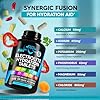Hyperglycemia, whether resulting from diabetes or other metabolic dysregulations, is a well-established contributor to chronic inflammation.
When combined with the persistent presence of SARS-CoV-2 spike proteins in the body, the inflammatory cascade is amplified, exacerbating existing disease conditions or hastening the onset of new ones.
This synergistic effect may partially explain the excess mortality observed globally since 2021.
How Hyperglycemia Fuels Inflammation
1. Pro-Inflammatory State:
-
- Chronic hyperglycemia induces the production of advanced glycation end products (AGEs) and their interaction with receptor proteins (RAGEs), which trigger oxidative stress and the release of pro-inflammatory cytokines such as interleukin-6 (IL-6) and tumor necrosis factor-alpha (TNF-α).
- Reference: Yan, S. F. et al. (2009). “The RAGE Pathway: Implications for Diabetic Complications and Inflammation.” Nature Reviews Endocrinology.
2. Endothelial Dysfunction:
-
- Elevated glucose levels impair endothelial cell function, leading to increased vascular permeability and a heightened inflammatory response.
- When spike proteins bind to endothelial ACE2 receptors, the combination accelerates vascular damage, raising the risk of heart attacks, strokes, and microvascular complications.
- Reference: Saltiel, A. R., & Olefsky, J. M. (2017). “Inflammatory Mechanisms Linking Obesity and Metabolic Disease.” The Journal of Clinical Investigation.
3. Immune Dysfunction:
-
- Hyperglycemia suppresses key immune responses, including the activity of neutrophils and macrophages.
- This allows persistent spike proteins to evade clearance, prolonging their tissue inflammatory effects.
- Reference: Marik, P. E. (2012). “The Role of Glucose and Glycemic Control in Critical Illness.” Chest.
Spike Protein and Hyperglycemia: A Vicious Cycle
1. Spike Protein-Induced Insulin Resistance:
-
- Studies suggest that SARS-CoV-2 infection and spike protein presence can impair pancreatic beta-cell function and exacerbate insulin resistance, even in non-diabetic individuals.
- This creates a feedback loop in which hyperglycemia worsens inflammation, further damaging metabolic regulation.
- Reference: Sathish, T., & Kapoor, N. (2021). “SARS-CoV-2 and Hyperglycemia: A Double-Edged Sword.” Diabetes Research and Clinical Practice.
2. Increased Susceptibility to Complications:
-
- Hyperglycemia amplifies the inflammatory and thrombotic risks associated with persistent spike protein activity, contributing to the development or worsening of cardiovascular diseases, kidney dysfunction, and neuroinflammation.
The Link to Excess Deaths
Since 2021, a notable increase in excess deaths has been reported globally. Several factors point to the interaction between persistent spike proteins, chronic hyperglycemia, and inflammation as contributing mechanisms:
1. Accelerated Disease Progression:
-
- Persistent inflammation triggered by spike proteins, combined with hyperglycemia, may lead to faster progression of atherosclerosis, heart failure, and other chronic conditions.
2. Increased Cancer Incidence:
-
- Hyperglycemia enhances the proliferation of cancer cells by providing a favorable metabolic environment. The impaired immune surveillance caused by spike protein persistence and hyperglycemia further facilitates tumor growth.
3. Weakened Resilience to Infections:
-
- Individuals with chronic hyperglycemia exhibit impaired immunity, leaving them vulnerable to secondary infections, sepsis, and other complications, which may explain part of the excess mortality.
Articles about excess deaths
Take Away Message
Given that almost everyone has been exposed to SARS-CoV-2 through infection, vaccination, or both, it is impossible to determine who may still harbor persistent viral remnants, such as spike proteins, in their bodies.
These remnants can trigger or exacerbate chronic inflammation, autoimmune conditions, or other medical complications.
With the insights from this article, one critical step is to maintain optimal blood sugar levels.
Persistent hyperglycemia can amplify the inflammatory state caused by SARS-CoV-2 remnants, accelerating the onset and worsening of associated diseases.
By controlling blood sugar through healthy lifestyle choices, regular monitoring, and timely medical intervention, we can reduce the risk of these complications and promote overall health.
Let this knowledge empower proactive measures for better long-term health outcomes.
Don’t Get Sick!
Stay current by subscribing. Feel free to share and like.
If you find value in this website, please consider buying a coffee or two or five to show your support.
References
- Bansal, S. et al. “Persistence of SARS-CoV-2 Spike Protein in the Plasma of Individuals Post COVID-19 Infection.” Frontiers in Immunology.
- Röltgen, K. et al. “Spike Protein Detection in Plasma Post-mRNA Vaccination.” Cell Reports Medicine.
- Lei, Y. et al. “SARS-CoV-2 Spike Protein Impairs Endothelial Function via ACE2 Interaction.” Circulation Research.
- Irrgang, P. et al. “IgG4 Class Switching in Response to mRNA Vaccines.” Science Immunology.
- Dotan, A. et al. “SARS-CoV-2 Spike Protein and Autoimmune Diseases.” Frontiers in Immunology.
- Singh, P. et al. “Spike Protein and Immune Surveillance in Cancer.” OncoImmunology.
- Wang, Q. et al. “Oncogenic Pathways Activated by SARS-CoV-2 Spike Protein.” Cell.
- Yan, S. F., et al. (2009). “The RAGE Pathway: Implications for Diabetic Complications and Inflammation.” Nature Reviews Endocrinology.
- Saltiel, A. R., & Olefsky, J. M. (2017). “Inflammatory Mechanisms Linking Obesity and Metabolic Disease.” The Journal of Clinical Investigation.
- Marik, P. E. (2012). “The Role of Glucose and Glycemic Control in Critical Illness.” Chest.
- Sathish, T., & Kapoor, N. (2021). “SARS-CoV-2 and Hyperglycemia: A Double-Edged Sword.” Diabetes Research and Clinical Practice.
© 2018 – 2024 Asclepiades Medicine, LLC. All Rights Reserved
DrJesseSantiano.com does not provide medical advice, diagnosis, or treatment
As an Amazon Associate, I earn from qualifying purchases.































